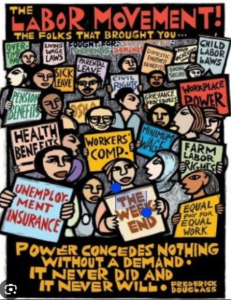
By PolitiFact Staff March 5, 2025
President Donald Trump recapped six weeks of aggressive efforts to cut the federal workforce, reorganize the economy and reorient foreign policy in his first address to a joint session of Congress.
The March 4 speech was long by historical standards — about an hour and 40 minutes — and it inspired more opposition party pushback than any in recent memory.
House Speaker Mike Johnson, R-La., ejected Rep. Al Green, D-Texas, a longtime Trump critic, after Green disrupted Trump a few minutes into his speech; Republicans cheered Green’s removal. As Trump mentioned law enforcement, some Democratic lawmakers shouted “January 6,” referring to the 2021 Capitol riot that led to numerous injuries and deaths among the Capitol Police force. Johnson banged his gavel and called for decorum.
Trump emphasized his commitment to following through on tariffs, including those that went into effect earlier in the day against Canada, Mexico and China.
“Tariffs — they’re about protecting the soul of our country,” Trump said. “There will be a little disturbance, but we’re OK with that. It won’t be much.” To farmers, who have worried about retaliatory tariffs against the crops they export, Trump said, “It may be a little bit of an adjustment,” but he urged them to “have a lot of fun — I love you, too.”
Social Security databases show “3.5 million people from ages 140 to 149 and money is being paid to many of them.”
False.
Trump recited numbers from a chart Elon Musk shared on X that showed millions of people in a Social Security database over the age of 100, including about 3.5 million in the 140 to 149 age bracket and one in the 360-369 age bracket.
The acting Social Security commissioner said that people older than 100 who do not have a date of death associated with their Social Security record “are not necessarily receiving benefits.” Recent Social Security Administration data shows that about 89,000 people ages 99 and older receive Social Security payments.
Government databases may classify someone as 150 years old for reasons peculiar to the complex Social Security database or because of missing data, but that doesn’t mean that millions of payments are delivered fraudulently to people with implausible ages.
Government Spending
“We found hundreds of billions of dollars of fraud.”
False.
Trump created the Department of Government Efficiency by executive order on his first day in office.
As of March 4, the DOGE website showed $105 billion in savings. But its “wall of receipts,” where it claims to track savings generated from DOGE’s cuts, showed less than $20 billion. That “wall of receipts” has been riddled with errors.
The White House has singled out federally funded projects it disagrees with ideologically, such as those about diversity, equity and inclusion or climate change. But that doesn’t prove fraud, which is determined by courts and requires a crime and intent to deceive.
The hunt for fraud is not new. For decades, inspectors general have searched for fraud in government agencies with some investigations leading to prosecutions. The Government Accountability Office last year estimated that fraud might cost the federal government $233 billion to $521 billion a year, citing 2018 to 2022 data.
“$1.9 billion (went) to recently created decarbonization of homes committee,” which was “headed up” by Stacey Abrams.
False.
Trump listed several federal spending items he characterized as examples of “appalling waste.” His list included a mention of “$1.9 billion to recently created decarbonization of homes committee, headed up — and we know she’s involved, just at the last minute the money was passed over — by a woman named Stacey Abrams. Have you ever heard of her?”
There’s no evidence Abrams, the two-time Democratic candidate for Georgia governor, directly received any grant money or engaged in illegal behavior.
Trump’s claim appears to refer to a $2 billion Environmental Protection Agency grant awarded to a coalition of five clean energy groups called Power Forward Communities. That coalition included Rewiring America, where Abrams, an attorney, was senior legal counsel from March 2023 until 2024. The grant, which the EPA awarded under then-President Joe Biden, will fund energy efficient housing projects around the country.
Immigration
“Over the past four years, 21 million people poured into the United States, many of them were murderers, human traffickers, gang members and other criminals from the streets of dangerous cities, all throughout the world.”
False.
Immigration officials encountered immigrants illegally crossing the U.S. border around 10.4 million times from February 2021, Biden’s first full month in office to January 2025, his last.
When accounting for Congressional Republicans’ September 2024 “got aways” estimate — people who border officials don’t stop — the number rises to about 12.4 million.
But encounters aren’t the same as admissions. Encounters represent events, so one person who tries to cross the border twice counts as two encounters. Also, not everyone encountered is let into the country. The Department of Homeland Security estimated that about 4.5 million encounters led to expulsions or removals from February 2021 through November 2024.
“Illegal border crossings last month were by far the lowest ever recorded, ever.”
Half True.
U.S. Customs and Border Protection has not published official February data. Trump said March 1 that in February, “there were only 8,326 apprehensions” by Border Patrol agents.
Monthly data has been collected only since 2000. The number Trump cited is the lowest number of monthly illegal crossings between ports of entry since Border Patrol began reporting monthly data. Officials recorded 11,000 encounters in April 2020, the previous low, amid the COVID-19 pandemic in Trump’s first term.
Before 2000, data was annual. We took that annual data and divided it by 12 to find an average monthly figure. Based on those calculations, average monthly apprehensions were below 8,000 from 1960 to 1968, according to federal data.
It’s likely that Trump’s hard-on-immigration approach has played a role in decreasing illegal immigration, but it has been dropping since March 2024, during Biden’s administration.
Economy
Through tariffs, “we will take in trillions and trillions of dollars that create jobs like we have never seen before. I did it with China, and I did it with others.”
Part of Trump’s claim is predictive, but the effects of his first-term round of tariffs were not as positive as he said.
In 2018, Trump levied 25% tariffs on steel and 10% tariffs on aluminum, although some countries, including major trading partners Canada and Mexico, were fully or partially exempted. Under Biden, the U.S. negotiated with Europe and Japan to lift those tariffs, but tariffs on other countries, notably China, remained.
Trump also authorized tariffs on billions of dollars of Chinese products, prompting China to retaliate with tariffs of up to 25% on U.S. exports to China. Also, Trump imposed up to 30% tariffs on solar panels and a 20% tariff on washing machines.
We examined more than a dozen academic and think-tank studies on the effect of Trump’s first-term tariffs. Some found gains for domestic industries that had foreign competitors hit with tariffs, but numerous analyses found that, on balance, tariffs’ negative affect the economy and consumer costs were bigger. Even when certain companies or industries benefited, studies concluded that tariffs are an inefficient way to deliver gains to domestic producers.
Independent estimates of prospective tariff revenue are modest. The center-right Tax Foundation estimated that the first year of tariffs on China, Canada, Mexico and other countries would bring in $140 billion, which would not make much of a dent in the $1 trillion deficit.
“Joe Biden, especially, let the price of eggs get out of control.”
Half True.
The price of eggs has risen dramatically, but this omits that the price hikes occurred during an outbreak of bird flu.
During the Biden administration, more than 100 million egg-laying chickens died from bird flu or were killed to stop the virus’ spread. This led to an egg shortage and higher prices.
Depopulation is a long-standing practice to prevent bird flu from spreading, agriculture experts said. This was also true during Trump’s first term; government documents show depopulation was the U.S. Department of Agriculture’s bird flu strategy then and during a 2015 outbreak under Obama.
Meanwhile, the price of eggs is higher now than it was during the peak under Biden. It has gone up by about $2 since Trump was sworn in.
Under the Biden administration, “we suffered the worst inflation in 48 years, but perhaps even in the history of our country, they’re not sure.”
Mostly False.
The highest year-over-year inflation rate on Biden’s watch was around 9% in summer 2022. It’s been about four decades since inflation ran that high. Trump exaggerated that there is room for doubt about that.
The highest year-over-year U.S. inflation rates were recorded in the 1970s and early 1980s, when the price increase sometimes ranged from 12% to 15%.
But Trump is incorrect that it’s the highest in U.S. history. In addition to the higher rates in the 1970s and early 1980s, the overall year-over-year inflation rate in 1946, after the U.S. won World War II, exceeded 18%.
International relations and foreign policy
“We’ve spent perhaps $350 billion, like taking candy from a baby” on Ukraine.
False.
The amount the U.S. has spent on Ukraine’s war with Russia varies depending on what’s being counted, but most estimates are in the $175 billion to $185 billion range, Mark Cancian, a senior defense and security adviser at the Center for Strategic and International Studies, previously told PolitiFact.
Ukraine Oversight, the website of the special inspector general for Operation Atlantic Resolve, which the U.S. government created in 2014 to coordinate its military aid to Ukraine, said that as of Sept. 30, 2024, the U.S. had spent $183 billion to help Ukraine.
The European Union has given roughly $145 billion in financial, military, humanitarian and refugee assistance.
Trump cites Panama and Greenland, two issues he didn’t raise on the campaign trail
Raising an expansionist theme he’s articulated in recent weeks, Trump said, “My administration will be reclaiming the Panama Canal” and said he had “a message tonight for the incredible people of Greenland: We strongly support your right to determine your own future, and if you choose, we welcome you into the United States of America.”
These riffs, combined with repeated suggestions that he’d like Canada to become the 51st state and his vision for a “Trump Gaza,” may or may not happen. But unlike many other things he’s done so far in office, a “Manifest Destiny” policy was not something he telegraphed to voters.
Trump had very little to say about foreign policy in the 75 campaign promises we’re tracking on the MAGA-Meter. Nor did the Trump-aligned Project 2025 dwell on these, beyond a more limited call to “enhance economic ties between the U.S. and Greenland, including through the establishment of a diplomatic presence.”
To the contrary, Trump has often bragged (not always accurately) about how, during his first term, he presided over peace and didn’t start any wars.
Mexico and Canada have “allowed fentanyl to come into our country at levels never seen before, killing hundreds of thousands of our citizens.”
Mostly False.
There’s a kernel of truth because most illicit fentanyl in the U.S. comes from Mexico and is made with chemicals from Chinese labs. It enters the U.S. mainly through the southern border at official ports of entry, and it’s smuggled in mostly by U.S. citizens.
But Trump wrongly characterizes what is happening at the U.S. border with Canada.
In fiscal year 2024, border officials seized nearly 22,000 pounds of fentanyl across U.S. borders. Less than 1% of that fentanyl, 43 pounds, was seized at the U.S.-Canadian border. In January 2025, border officials seized 1,000 pounds, and less than half a pound was seized at the northern border.
And he exaggerates the number of fentanyl overdose deaths, which have been dropping since 2023, according to data from the Centers for Disease Control and Prevention.
More than 53,000 people died of a synthetic opioid overdose in the 12-month period starting in October 2023 and ending September 2024, the latest available data. That’s a drop from more than 77,000 from October 2022 to September 2023.
The Paris accord was “costing us trillions of dollars.”
False.
The climate agreement wasn’t costing the U.S. trillions of dollars. It hypothetically could.
The Trump administration defended the decision to withdraw from the Obama-era climate agreement, in part, based on a consultant’s projections about the economic effects of restricting fossil fuel emissions.
NERA Economic Consulting said these changes would result in higher production cost, and a higher production cost would translate into the closure of uncompetitive manufacturing businesses. Those closures, in turn, would mean fewer manufacturing jobs. The job loss would result in a corresponding decline in gross domestic product, with a loss of $250 billion by 2025 that would accelerate to $3 trillion by 2040.
However, the study said that the long-term projections did not factor in all of the offsetting job gains and GDP growth associated with a clean tech transition.
Polling
“Now, for the first time in modern history, more Americans believe that our country is headed in the right direction than the wrong direction.”
Mostly False.
That’s cherry-picking the results of two polls conducted since Trump took office Jan. 20. Another 17 polls during that period describe Americans having strong “wrong track” sentiments.
According to an archive of “right-track/wrong-track” polling maintained by RealClearPolitics, two recent polls found more respondents saying the country is on the right track than saying it’s on the wrong track. A Rasmussen poll found a 1 percentage point edge for “right track,” while an Emerson College poll found a 4-point edge. Among pollsters, Rasmussen has consistently published higher approval ratings for Trump than its peers that track presidential job approval among Americans
However, all 17 other polls since Trump took office show “wrong track” leading “right track,” some by double-digit margins. RealClearPolitics’ average of all the polls shows “wrong track” sentiment leading “right track” sentiment by just under 10 points.
PolitiFact Chief Correspondent Louis Jacobson, Senior Correspondent Amy Sherman, Staff Writers Grace Abels, Maria Briceño, Madison Czopek, Loreben Tuquero, Maria Ramirez Uribe, Researcher Caryn Baird, Executive Director Aaron Sharockmanand KFF Health News Senior Correspondent Stephanie Armour contributed to this story.
Our live-event fact-checks rely on both new and previously reported work. We link to past work whenever possible. In some cases, a fact-check rating may be different tonight than in past versions. In those cases, either details of what the politician said, or how the politician said it, led us to reevaluate it on our Truth-O-Meter. Read more about our process.





























































































 Senator Booker’s speech, taking place Friday during the first General Session, electrified the crowd. “This state has
Senator Booker’s speech, taking place Friday during the first General Session, electrified the crowd. “This state has  The impact was visible. “I was sitting in a row with several activists who
The impact was visible. “I was sitting in a row with several activists who 






